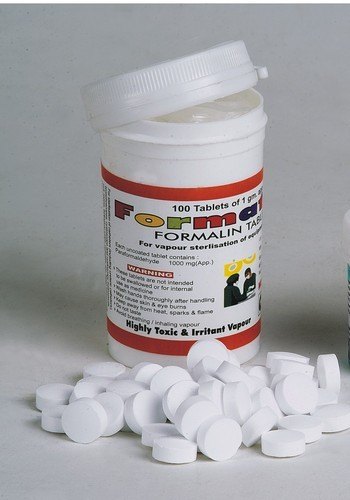Low-temperature steam with formaldehyde is used as a low-temperature sterilization method in many countries, particularly in Scandinavia, Germany, and the United Kingdom. The process involves the use of formalin, which is vaporized into a formaldehyde gas that is admitted into the sterilization chamber. A formaldehyde concentration of 8-16 mg/l is generated at an operating temperature of 70-75oC. The sterilization cycle consists of a series of stages that include an initial vacuum to remove air from the chamber and load, followed by steam admission to the chamber with the vacuum pump running to purge the chamber of air and to heat the load, followed by a series of pulses of formaldehyde gas, followed by steam. Formaldehyde is removed from the sterilizer and load by repeated alternate evacuations and flushing with steam and air.
This system has some advantages, e.g., the cycle time for formaldehyde gas is faster than that for ETO and the cost per cycle is relatively low. However, ETO is more penetrating and operates at lower temperatures than do steam/formaldehyde sterilizers. Low-temperature steam formaldehyde sterilization has been found effective against vegetative bacteria, mycobacteria, B. atrophaeus and G. stearothermophilus spores and Candida albicans.
Formaldehyde vapor cabinets also may be used in healthcare facilities to sterilize heat-sensitive medical equipment. Commonly, there is no circulation of formaldehyde and no temperature and humidity controls. The release of gas from paraformaldehyde tablets (placed on the lower tray) is slow and produces a low partial pressure of gas. The microbicidal quality of this procedure is unknown
Reliable sterilization using formaldehyde is achieved when performed with a high concentration of gas, at a temperature between 60o and 80oC and with a relative humidity of 75 to 100%. Studies indicate that formaldehyde is a mutagen and a potential human carcinogen, and OSHA regulates formaldehyde. The permissible exposure limit for formaldehyde in work areas is 0.75 ppm measured as a 8-hour TWA. The OSHA standard includes a 2 ppm STEL (i.e., maximum exposure allowed during a 15-minute period). As with the ETO standard, the formaldehyde standard requires that the employer conduct initial monitoring to identify employees who are exposed to formaldehyde at or above the action level or STEL. If this exposure level is maintained, employers may discontinue exposure monitoring until there is a change that could affect exposure levels or an employee reports formaldehyde-related signs and symptoms. The formaldehyde steam sterilization system has not been FDA cleared for use in healthcare facilities.
Friday, May 14, 2021
Refrences
Please Check out file at the following link
How long should sterilization monitoring records be maintained?


